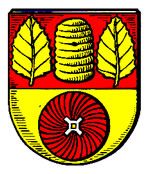Börger: Difference between revisions
Knorrepoes (talk | contribs) m (Text replacement - "50 px|link=Germany" to "") |
Knorrepoes (talk | contribs) m (Text replacement - "===Official blazon=== (de)" to "===Official blazon=== *(de)") |
||
| Line 10: | Line 10: | ||
===Official blazon=== | ===Official blazon=== | ||
(de) | *(de) | ||
===Origin/meaning=== | ===Origin/meaning=== | ||
The two birch leaves are a canting symbol, the name probably means birch-hills. The beehive is a symbol for the longtime tradition of apiculture in the region. The millstone is a symbol for the former water- and windmills in the area, needed to mill the buckwheat and rye that was cultivated in the municipality. The red and golden colours of the chief are also the colours of the Corvey Abbey, to which the area belonged since the 10th century, as well as of the diocese of Münster, to which the area belonged from the end of the 13th century until 1803. | The two birch leaves are a canting symbol, the name probably means birch-hills. The beehive is a symbol for the longtime tradition of apiculture in the region. The millstone is a symbol for the former water- and windmills in the area, needed to mill the buckwheat and rye that was cultivated in the municipality. The red and golden colours of the chief are also the colours of the Corvey Abbey, to which the area belonged since the 10th century, as well as of the diocese of Münster, to which the area belonged from the end of the 13th century until 1803. | ||
Revision as of 09:09, 9 February 2020
This page is part of the German heraldry portal |
Heraldry of the World |
|
German heraldry:
|
Selected collector's items from Germany:
|
BÖRGER
State : Niedersachsen
District (Kreis) : Emsland (until 1977 Aschendorf-Hümmling)
Samtgemeinde : Samtgemeinde Sögel
Official blazon
- (de)
Origin/meaning
The two birch leaves are a canting symbol, the name probably means birch-hills. The beehive is a symbol for the longtime tradition of apiculture in the region. The millstone is a symbol for the former water- and windmills in the area, needed to mill the buckwheat and rye that was cultivated in the municipality. The red and golden colours of the chief are also the colours of the Corvey Abbey, to which the area belonged since the 10th century, as well as of the diocese of Münster, to which the area belonged from the end of the 13th century until 1803.
Contact and Support
Partners:
Your logo here ?
Contact us
© since 1995, Heraldry of the World, Ralf Hartemink 
Index of the site












